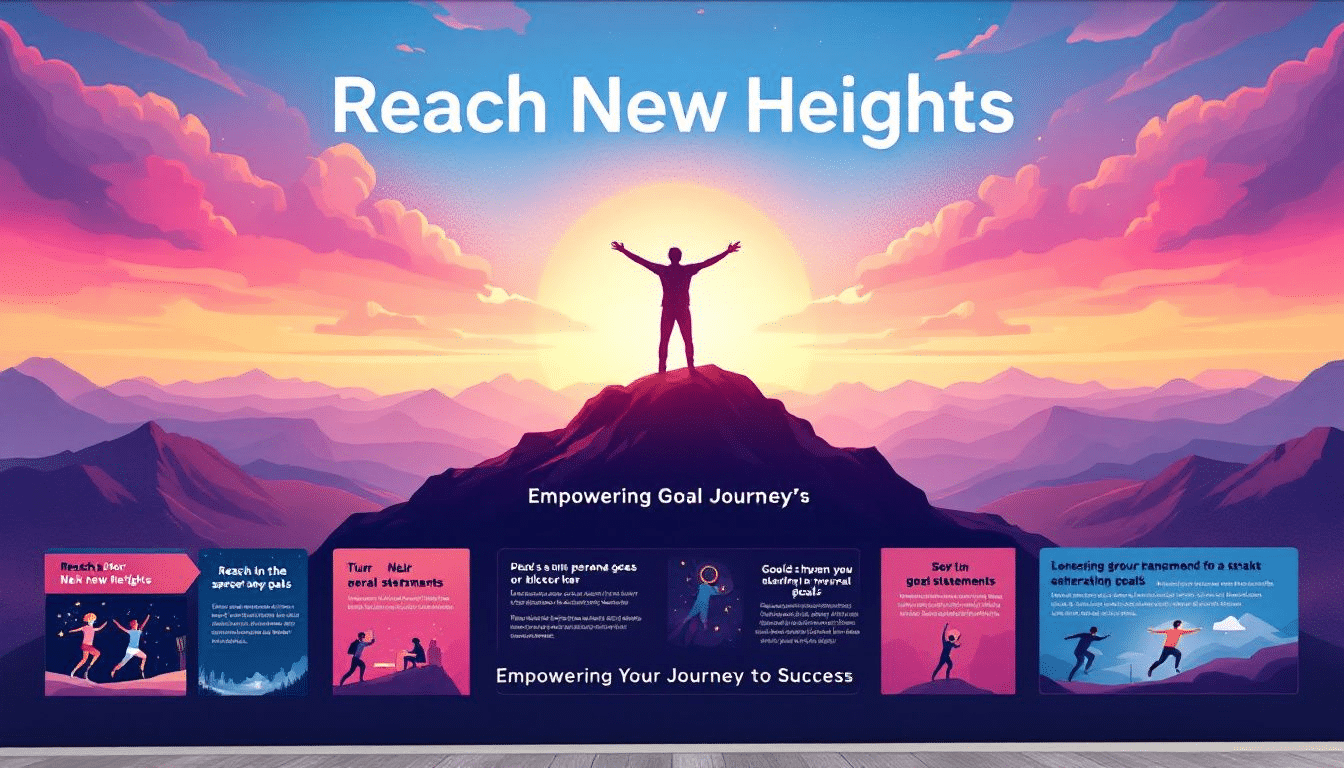Need an example of a goal statement? A goal statement outlines your objectives and steps to achieve them. This article gives practical examples of personal and professional goal statements, including an example of goal statement, to guide your own goal-setting.
Key Takeaways
-
Goal statements act as powerful tools that enhance motivation and clarity, serving as a roadmap for personal and professional aspirations.
-
Utilizing the SMART method ensures your goals are specific and measurable, increasing the likelihood of achieving them through structured action plans.
-
Regularly reviewing and celebrating milestones keeps you motivated and adaptable, allowing your goals to evolve with changing circumstances.
Understanding Goal Statements

Goal statements are invaluable tools that help individuals achieve personal and professional success. They serve as both a compass and a motivational tool, outlining a clear path toward one’s aspirations. Grasping the essence of goal statements helps guide you toward success in various aspects of life.
Crafting writing goal statements can significantly enhance motivation and keep you aligned with your career objectives and personal growth.
Definition of a Goal Statement
A goals statement provides a clear summary of your future objectives. It encompasses your vision, mission, and values. This personal statement can vary widely but should reflect your individual aspirations and motivations. Formally documenting a career goal statement enhances understanding and clarity regarding your objectives.
Similar to plotting a route on a roadmap, a career goal statement aids in planning the path to your professional objectives.
Importance of Goal Statements
Documenting a goal significantly enhances the likelihood of achieving it. Goal statements act as powerful motivators, offering a clear pathway to success. They enable individuals to reflect on achieved goals, boosting motivation and providing a sense of accomplishment.
Sharing goals with others enhances accountability, increasing the likelihood of completion by 65%.
Types of Goal Statements
Goal statements can be categorized into two primary types. These types are personal goal statements and business goal statements. Personal goals represent your identity and desires. They also indicate the direction you want your life to take. On the other hand, business goal statements are complex outlines of career objectives and the steps needed to achieve them.
Grasping both types is vital for effective goal setting and ensuring personal goals align with professional aspirations.
Examples of Personal Goal Statements

Personal goal statements can inspire readers on their goal-setting journey. These examples show how to set goals that align with personal development and career aspirations, offering clear direction and motivation.
Example 1: Career Advancement
A personal goal statement might focus on long-term career objectives, such as advancing to a leadership position.
Short-term goals could include:
-
Gaining experience
-
Attending leadership skills training
-
Networking
-
Earning certifications
An action plan outlines steps to achieve leadership goals and provides a roadmap for career advancement. For instance, unifying internal analytics processes across departments could enhance leadership qualifications.
Example 2: Skill Development
A goal statement focused on skill development might involve dedicating 30 minutes daily to language lessons for six months to achieve semi-fluency by next summer. Setting specific goals for skill development enhances motivation and allows for effective progress tracking.
This approach follows the SMART method, ensuring the goal is Specific, Measurable, Achievable, Relevant, and Time-bound. Clear goal statements lead to better focus, consistent practice, and an effective learning experience.
Example 3: Personal Growth
Personal growth goals are vital for enhancing various life areas, such as fitness and social connections. An example goal statement might involve following a 12-week structured training plan to complete a 10K run.
Another goal could be scheduling a coffee date with a friend before the end of the month, emphasizing the importance of building and maintaining social connections. Such goals significantly contribute to overall well-being and personal development.
Examples of Professional Goal Statements

Professional goal statements provide clarity and direction in a professional context. They are often clear, specific, and measurable, following the SMART framework.
Professional goals might include advancing to a leadership position, focusing on career development, or transitioning to a new career path, including specific career goals.
Example 1: Project Management
A professional goal statement for aspiring project managers could be to become a Project Lead at CompanyXYZ within five years. Achieving this might involve refining project management skills and obtaining a PMP Certification. Short-term goals could include attending seminars, taking classes, learning new skills, and networking.
This goal statement provides clear career direction and acts as a blueprint for personal development.
Example 2: Sales Team Leadership
For those aiming for a leadership role within a sales team, a goal statement might focus on improving sales metrics and fostering a collaborative team environment. Objectives might include boosting sales performance through targeted metrics and implementing team-building activities for better cohesiveness.
These objectives contribute to creating a successful and high-performing sales team.
Example 3: Business Expansion
A business goal statement might focus on expanding into new markets or increasing revenue by a specific percentage. For example, securing a public speaking gig for over 300 attendees within one year. Steps to achieve this could include refining public speaking abilities and networking with conference planners.
Short-term goals might involve gaining 100 new users for a product per month, while long-term goals could include writing articles and earning certifications.
Crafting Your Own Goal Statement

Creating a personalized goal statement involves self-reflection, using the SMART method, and developing an actionable plan. Writing down goals boosts performance and persistence by up to 90%, and vividly picturing or describing them increases the likelihood of achieving them by 1.2 to 1.4 times.
Self-Reflection and Passion
Identifying your passions and motivations is key to effective goal setting. Finding purpose in life significantly contributes to overall well-being. Methods to discover one’s passion include experimenting, volunteering, and freelancing.
This process aids in crafting a personal goal statement aligned with your personal vision and aspirations.
Using the SMART Method
The SMART method—Specific, Measurable, Achievable, Relevant, and Time-bound—clarifies objectives, tracks progress, and ensures feasibility. A well-defined goal includes clear direction and realistic timelines, along with practical action plans.
Measurable milestones help track progress in skill acquisition.
Developing an Action Plan
An action plan outlines steps to achieve a goal and serves as a roadmap. Milestones for short-term and long-term goals should be included in a goal statement timeline. Setting a clear destination and acquiring necessary skills are vital when setting professional goals.
Clear goals clarify what skills you’ll need to develop or refine.
Tips for Maintaining and Revising Goal Statements

Maintaining and revising goal statements ensures they remain relevant and effective. Regular reviews, flexibility, and celebrating milestones are key strategies.
Regular Review and Tracking
Regularly reviewing goal statements ensures alignment with long-term objectives. Consistent progress reviews help stay on track with defined goals and provide direction and motivation.
Tracking progress ensures goals remain aligned with evolving life circumstances.
Flexibility and Adaptability
Flexibility in goal setting is crucial due to life’s unpredictability, which may require goal adjustments. Retaining previous goals helps track evolution and adjust resources or timelines accordingly.
Flexibility enables quick responses to unforeseen developments and fosters creativity and innovative solutions.
Celebrating Milestones
Acknowledging milestones boosts motivation and reinforces commitment to achieving larger goals. Celebrating milestones recognizes progress and maintains motivation throughout the goal achievement process.
Celebrating smaller achievements fosters a sense of accomplishment, propelling individuals toward their overarching objectives.
Learning from Real-World Examples
Learning from successful individuals shows how effective goal setting can lead to remarkable achievements. Embracing changes while pursuing goals often leads to outcomes that far exceed initial expectations.
Example: Elon Musk’s Vision
Elon Musk’s ambitious goals and relentless pursuit of innovation have inspired countless individuals. Musk founded SpaceX with the ambition to eventually colonize Mars. His goal with Tesla is to revolutionize the automotive industry with electric vehicles and drive the world toward sustainable energy.
Example: Oprah Winfrey’s Journey
Oprah Winfrey’s career is a testament to setting clear goals and demonstrating how determination and vision can lead to unprecedented success. Her goal was to create a media empire that empowered and inspired others.
Through her media platform, Winfrey aims to inspire others by sharing her life experiences and promoting personal growth.
Summary
In summary, goal statements are powerful tools that can guide you toward personal and professional success. By understanding their importance, learning from examples, and crafting your own effective goal statements, you can set a clear direction for your ambitions. Remember to maintain and revise your goals regularly, embrace flexibility, and celebrate milestones along the way. Let these insights inspire you to turn your aspirations into achievements. Now, go forth and conquer your goals with confidence!
FAQ
What is a goal statement?
A goal statement is a clear and concise outline of your vision, mission, and values, guiding you toward your future aspirations. Embrace this powerful tool to steer your personal and professional journey with purpose!
Why are goal statements important?
Goal statements are crucial as they boost your motivation and clarity, making your aspirations tangible and achievable. By putting your goals in writing, you create a clear roadmap to success!
What are some examples of personal goal statements?
Crafting a personal goal statement can be empowering; consider setting objectives like advancing your career, acquiring new skills, or achieving personal growth. Whether it’s gaining leadership experience or tackling a fitness challenge, let your aspirations drive you forward!
How can I craft my own goal statement?
Crafting your own goal statement begins with self-reflection on your passions and motivations. Use the SMART method to define your goals clearly and develop a concrete action plan to achieve them!
How do I maintain and revise my goal statements?
To maintain and revise your goal statements, regularly review your progress and stay flexible to adapt your goals as life changes. Celebrate your milestones to keep your motivation high and your commitment strong!
